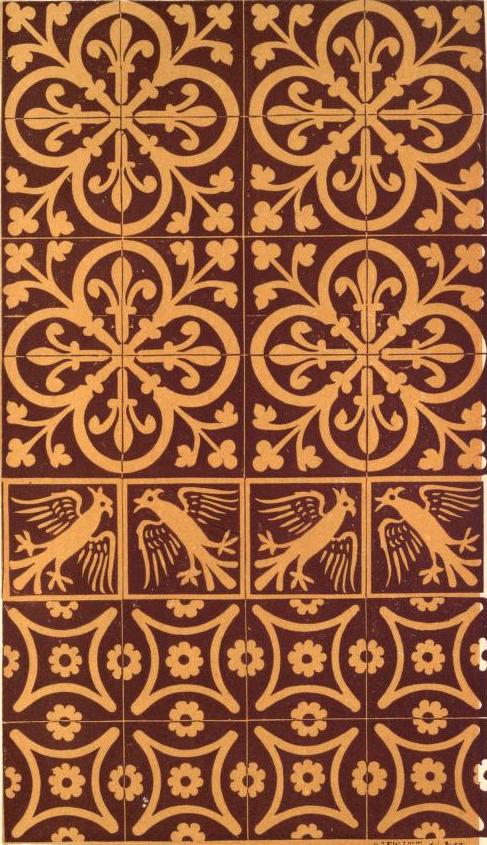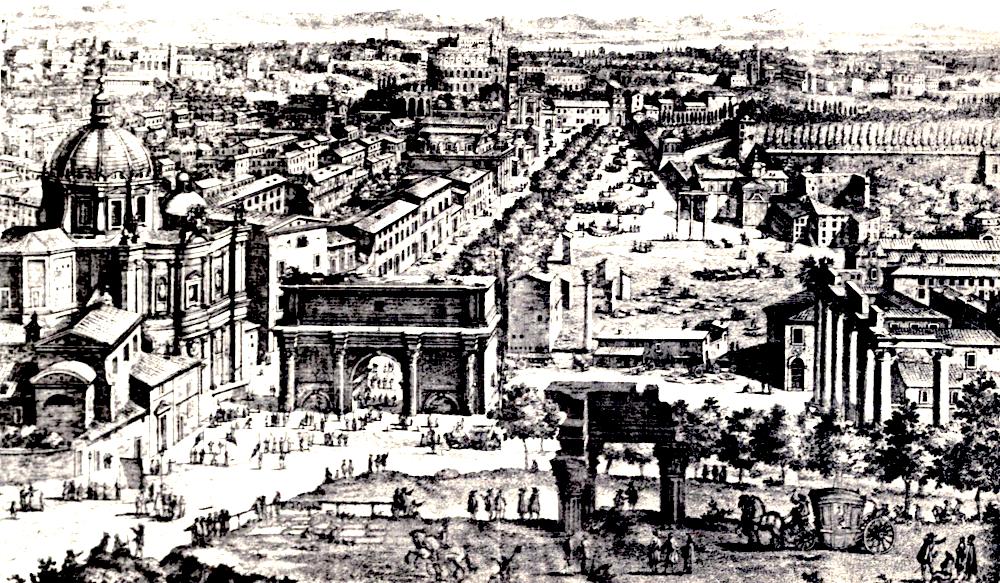Many thanks to Rita Wood, for bringing John Henry Parker to my attention. You may use the images in the following piece without prior permission for any scholarly or educational purpose as long as you (1) credit the author and the Internet Archive, and (2) link your document to this URL in a web document or to the Victorian Web in a print document. [Click on the images to enlarge them.]

Portrait accompanying the
Illustrated London News obituary.

ohn Henry Parker was the publisher who brought out George Gilbert Scott's A Plea for the Faithful Restoration of Our Ancient Churches (1850). But the association with Scott hints at rather more than the bare fact that he published his "plea." Parker was, in fact, a learned man, who keenly supported the Oxford Movement, published its tracts, was a good friend of Cardinal Newman's, produced what was almost a bible of Gothic architecture for use by the church architects of the day, and was also a prominent antiquarian, active in the new and expanding field of Victorian archaeology.
Parker was born to John and Caroline Elizabeth Parker in their home at 157 Strand, London, on 1 March 1806. He was educated at the Manor House School, Chiswick, and apprenticed to his uncle Joseph, a bookseller and publisher in partnership with W. Hanwell in Oxford (see Riddell). As the agent of the university's publications, he matriculated from it as "bibliopola privilegiatus," and on his uncle's retirement took over the business entirely. "John Henry Parker, Broad Street, Oxford" flourished to the extent that from 1847 it became "John Henry Parker (Oxford and London)." He had married Frances Mary Hoskyns, daughter of the Rev. John Leigh Hoskyns, a Fellow of Magdalen and the incumbent of Appleton, in Berkshire. His wife died in middle age, in 1850, but their only child James (1833-1912) duly became his partner in 1855, so that the firm then became "John Henry and James Parker, Oxford and London." Notable among their more general publications was the popular Oxford Classics series.

Medieval encaustic Tiles, Woodferry (Parker, ed. A Guide to the Architectural Antiquities in the Neighbourhood of Oxford, following p. 236).
As a stout supporter of the Tractarians, "particularly as it related to ecclesiology," he not only became a friend of Cardinal Newman, but remained one even after Newman joined the Roman Catholic church (Riddell). Early on, he developed a particular interest in architecture, writing about it at length himself, so that he was described in his Oxford Magazine obituary as "one of the prominent names in the literature of the beginning of the Gothic Revival" (145). Another obituary, in the Illustrated London News, gives the main points of his work in this area: "In 1836 he published his Glossary of Architecture, and in 1849 his Introduction to the Study of Gothic Architecture, originally a series of elementary lectures delivered to the junior members of the Oxford Architectural Society. This was followed, after a short interval, by Domestic Architecture of the Middle Ages. He also edited the fifth edition of Rickman’s Gothic Architecture" (157). But even this hardly does credit to his main publishing achievements. The glossary went through ten editions during the nineteenth century. He brought out a companion to it in 1841, and also issued a popular abridged version of it (A Concise Glossary, from 1846 onwards).
The Illustrated London News obituary also misses out Parker's Dictionary of Architecture (into its third edition in 1840) and the more local books he edited, partly wrote and published, A Guide to the Architectural Antiquities in the Neighbourhood of Oxford (1842), and Handbook for Visitors to Oxford (1847). Two other local guides were The Medieval Architecture of Chester (1858), and The Architectural Antiquities of the City of Wells (1866). But the obituary does add, "he was the author of The Archeology of Rome, and of several papers on medieval architecture in the Archeologia, Archeological Journal, and Gentleman’s Magazine" (157).

The Roman Forum in 1650 — At the Jubilee (Forum Romanum, Plate I).
As some of these titles suggest, an important strand of Parker's career was his interest in archeology. To the Archeologia, for example, he contributed a series on the "Ancient Churches in the west of France" (Riddell). He became a Fellow of the Society of Antiquaries in 1849, and after he retired in 1862, and visited Italy for health reasons, he founded the British Archaeological Society of Rome (soon to become the British and American Archaeological Society of Rome). In 1867 he was awarded an honorary MA at Oxford, and in 1869 the university gave him a grant of £200 to help with excavations already being made in Rome under his direction. Out of his work in Italy came Mosaic Pictures in Rome and Ravenna (1866) and The Archaeology of Rome (1874–6).
At home, meanwhile, he became Keeper of the British Collections at the Ashmolean at Oxford in 1870: "Although he was often away from the museum due to ill health, he was a good custodian of the collections" (MacGregor). No wonder he was often absent: another important task of these years was his supervision of the Catalogue of 3,300 Historical Photographs of Antiquities in Rome and Italy which he brought out as a series from 1867 onwards. This was issued in a revised and enlarged edition in 1883: "The collection is of considerable interest, as it documents the excavations made in the second half of the 19th century" ("Parker Collection").
Parker's publishing career was not quite as stellar as it sounds: unfortunately for his reputation even then, he was not above pirating others' work. At the beginning of his Companion, for example, he explains how he came by an earlier compilation by John Britton (1777-1851), and set about "extracting so much of Mr. Britton’s Dictionary as suited that object, in preference to reprinting the whole as a separate work" (11), making it clear that, in the process, he has put a great deal of extra research into it. Similarly, he has drawn on Thomas Willement, of stained glass fame, for his knowledge of heraldry. However, such borrowings are credited. Perhaps more dubious was his scholarship, which was apt to be called into question by more scrupulous scholars. This again was something of which he was aware, on one occasion citing "the want of time and opportunity to examine the history of each particular building with sufficient minuteness" (Companion, 30). More generally, he was also out of step with John Ruskin's ideas about restoration and William Morris's "Anti-Scrape" movement.

First page of the 1850 edition
of the Glossary.
Nevertheless, Parker was tremendously influential, and his work, replete with illustrations, was widely consulted and disseminated. For example, J. L. Pearson's design for the bellcote of St Mary's church, Ellerton in the East Riding of Yorkshire is thought to have been a re-working of "that at Shipton Oliffe in Gloucestershire, which was illustrated in Parker's much-used Glossary of Terms" — as too was the "articulated tracery of the E window" (Pevsner and Neave 401).
Parker's achievements were recognised in his own lifetime by the award of various honours, including a CB (just short of a knighthood) in 1871 and a gold medal from the Pope (Pious IX). He died in Oxford on 31 January 1884, aged 77, and was buried at St Sepulchre's Cemetery there; his funeral was very well attended and his death was widely noted in the press.
Bibliography
"John Henry PARKER, C.B. (1806–1884) His wife Mrs Frances Mary PARKER, née Hoskyns (1805–1854)." St Sepulchre's Cemetery. Web. 8 April 2022.
"The Late Mr. John Henry Parker." The Illustrated London News. 16 February 1884: 157. Internet Archive. Sponsored by the Kahle/Austin Foundation. Web. 8 April 2022.
MacGregor, Arthur. "History of the British Collections: The Nineteenth Century." . Web. 8 April 2022.
"Mr. J. H. Parker." Oxford Magazine. 6 February 1884. 45. Google Books. Free Ebook.
"Parker Collection." Jstor. Web. 8 April 2022.
Parker, J. H. Forum Romanum. Oxford: J. Parker; London: J. Murray, 1876. Internet Archive. Sponsored by the Sloan Foundation. Web. 8 April 2022.
_____. A Companion to the Fourth Edition of a Glossary of Terms used in Grecian, Roman, Italian, and Gothic Architecture. Oxford: John Henry Parker, 1845. Internet Archive. Contributed by the Getty Research Institute. Web. 8 April 2022.
_____. A Glossary of Terms used in Grecian, Roman, Italian, and Gothic Architecture: exemplified with seventeen-hundred woodcuts. Oxford: John Henry Parker, 1850. Internet Archive. Contributed by the Getty Research Institute. Web. 8 April 2022.
_____, ed. A Guide to the Architectural Antiquities in the Neighbourhood of Oxford. Oxford: John Henry Parker, 1846. Internet Archive. Contributed by Robarts Library, University of Toronto. Web. 8 April 2022.
Pevsner, Nikolaus. Some Architectural Writers of the Nineteenth Century. Oxford: Clarendon Press, 1972. See "The Cambridge Camden Society and the ecclesiologists," pp. 123-33.
Pevsner, Nikolaus, and David Neave. Yorkshire: York and the East Riding. New Haven and London: Yale University Press, 2002.
Riddell, Richard. "Parker, John Henry (1806–1884), writer on architecture and publisher." Oxford Dictionary of National Biography. Online ed. Web. 8 April 2022.
Created 8 April 2012; last modified 31 October 2023